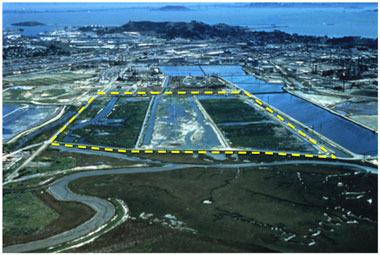 Perhaps our most striking success is the demonstration that constructed wetlands can cleanup the toxic element, selenium (Se), from large volumes of industrial wastewater. Research conducted at the Chevron oil refinery at Richmond, CA, demonstrated that 89% of the selenium from oil refinery wastewater was removed by a 90-acre constructed wetland that processed approximately 2 to 3 million gallons (~10 million liters) of refinery effluent per day. This study revealed that 20 to 30% of the toxic selenium entering the wetland was released to the atmosphere in non-toxic volatile forms, a process known as biological volatilization. This is extremely important as the selenium removed by volatilization cannot enter the local food chain. This research stimulated substantial media interest including articles in the San Francisco Chronicle, the San Jose Mercury, the Sacramento Bee, Science News, as well as television reports: KRON, CNN and the BBC (UK) all sent teams to Berkeley to film the wetland story.
Perhaps our most striking success is the demonstration that constructed wetlands can cleanup the toxic element, selenium (Se), from large volumes of industrial wastewater. Research conducted at the Chevron oil refinery at Richmond, CA, demonstrated that 89% of the selenium from oil refinery wastewater was removed by a 90-acre constructed wetland that processed approximately 2 to 3 million gallons (~10 million liters) of refinery effluent per day. This study revealed that 20 to 30% of the toxic selenium entering the wetland was released to the atmosphere in non-toxic volatile forms, a process known as biological volatilization. This is extremely important as the selenium removed by volatilization cannot enter the local food chain. This research stimulated substantial media interest including articles in the San Francisco Chronicle, the San Jose Mercury, the Sacramento Bee, Science News, as well as television reports: KRON, CNN and the BBC (UK) all sent teams to Berkeley to film the wetland story.
